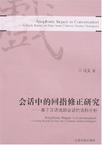会话中的回指修正研究-基于汉语戏剧会话的语料分析
2007-8
山东山大图书有限公司
马文
313
无
《会话中的回指修正研究:基于汉语戏剧会话的语料分析》采用的是会话分析的视角,将会话中的语篇回指,视为交际双方在基本会话合作原则指导下,采用的指称照应管理手段及其结果,着重探讨说话者为了纠正会话交际中实际存在或可能出现的回指指代不清或误解而作出的修正。从这一视角研究语篇回指的好处是,可以从说话者何时、何处、在何种情况下作出何种回指修正中,反观和逆向推测交际双方在使用回指时所遵循的合作原则。《会话中的回指修正研究:基于汉语戏剧会话的语料分析》的创新性也就表现在从这一视角对语篇回指的深入观察和思考中,主要体现在如下观察、描述和解释三个方面。
马文,男,1972年生,山东梁山人。2004年6月毕业于上海外国语大学,获外国语言学及应用语言学博士学位。2006年10月至2007年9月作为荣誉访问学者赴英国约克大学访问,其问在约克大学交际研究中心从事博士后研究工作,方向为“日常会话中人称指代的会话分析研究”。现为山东大学外国语学院副教授、硕士生导师。研究方向为对比语言学、会话分析及认知语言学。在《外国语》、《外语学刊》、《外语教学》、《解放军外国语学院学报》等核心期刊上发表学术论文近二十篇。目前主持2006国家社科基金项目一项,主持山东大学校级课题一项,另参加国家社科基金项目和山东省社科基金项目各一项。
Chapter One Introduction1.1 Conversational Repair and Anaphoric Repair1.1.1 Definition of conversational repair1.1.2 Toward a definition of anaphoric repair1.2 A Brief Literature Review1.3 General Aims and Objectives1.4 Methodology1.5 Data Used for Analysis1.6 Organization of the Present StudyChapter Two Classifications of Anaphoric Repair2.1 Introduction2.2 A Functional Classification2.2.1 Anaphoric repair for referential unclearness2.2.2 Anaphoric repair for lexieal understanding2.2.3 Anaphoric repair for identity negotiation2.2.4 Anaphoric repair for listening problem2.2.5 Anaphoric repair for speaking error ~2.3 Appropriateness-repair Versus Error-repair2.4 A Formal Classification2.4.1 Repair of a pronominal form2.4.2 Repair of a non-pronominal form2.5 SummaryChapter Three Basic Patterns and Structural Preferences of Anaphorie Repair3.1 Introduction3.2 Basic Patterns and Structural Preferences of Conversational Repair3.3 Four Patterns of Anaphoric Repair3.3.1 Self-initiated self-repair3.3.2 Other-initiated self-repair3.3.3 Other-initiated other-repair3.3.4 Self-initiated other-repair3.4 Structural Preferences of Anaphoric Repair in Chinese Conversation3.4.1 Distribution of the four basic patterns of anaphoric repair3.4.2 Self-initiation versus other-initiation3.4.3 Self-repair versus other-repair3.5 SummaryChapter Four Initiation Types and Techniques in Anaphoric Repair4.1 Introduction4.2 Initiation Types4.2.1 Specific information request4.2.2 Non-specific request for repetition4.2.3 Expression of lexical uncertainty4.2.4 Candidate understanding4.2.5 Clarification,request4.2.6 Objection4.2.7 Preemptive initiation4.2.8 Minimal dysfluency4.2.9 Without explicit initiation marker4.3 Initiation Techniques4.3.1 Question particle or question word4.3.2 Repeat of the trouble source4.3.3 Repeat of the trouble sourceq-question word4.3.4 Question4.3.5 Candidate alternative4.3.6 Negative word or clause4.3.7 Sound stretch, cut-off or non-lexical filler4.3.8 Without separable initiator4.3.9 The scale of initiation techniques4.3.10 Practices of combining different techniques4.4 SummaryChapter Five Repair Strategies in Anaphoric RepairChapter Six Referential Choice and Interpretation of Anaphoric RepairChapter Seven Conclusion附录 中国现代戏剧Bibliography

无
会话中的回指修正研究-基于汉语戏剧会话的语料分析 PDF格式下载